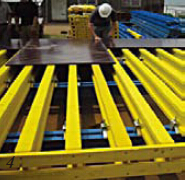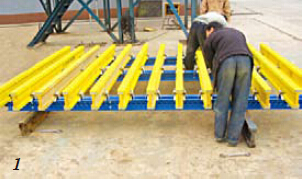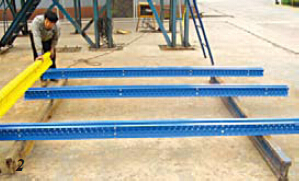Timber-Beam Plywood Formwork for Building Construction
- Loading Port:
- Tianjin
- Payment Terms:
- TT OR LC
- Min Order Qty:
- 50 m²
- Supply Capability:
- 1000 m²/month
OKorder Service Pledge
Quality Product, Order Online Tracking, Timely Delivery
OKorder Financial Service
Credit Rating, Credit Services, Credit Purchasing
You Might Also Like
Plywood --- make perfect concrete surface
WISA-Form Birch is a coated special plywood using in the formwork systems where high
requirements are set on the concrete surface and the times of reuses.
With CNBM timber beam & WISA plywood, the formwork is low weight but high load capacity, it is
widely used in construction.
Characteristics:
◆ Component with high standardization.
◆ Assembling in site, flexible application.
◆ Light weight, easy transportation and storage.



- Q:How does steel formwork affect the construction timeline?
- Steel formwork can significantly impact the construction timeline in a positive way. Due to its durability and strength, steel formwork offers faster installation and removal compared to traditional timber formwork. This expedites the construction process, allowing for quicker concrete pouring and curing times. Additionally, steel formwork provides better dimensional accuracy and reusability, reducing the time required for adjustments and replacements. Overall, the use of steel formwork can help streamline construction activities, leading to shorter project durations and improved efficiency.
- Q:What are the standard sizes of steel formwork panels?
- The standard sizes of steel formwork panels vary depending on the manufacturer and project requirements. However, commonly used sizes include 1.2 meters by 2.4 meters (4 feet by 8 feet), 1.5 meters by 3 meters (5 feet by 10 feet), and 2.4 meters by 3.6 meters (8 feet by 12 feet).
- Q:What are the common accessories used with steel formwork?
- Steel formwork commonly utilizes various accessories such as form ties, wedges, form release agents, formwork clamps, and form liners. Form ties play a crucial role in securing the formwork and maintaining its position throughout the concrete pouring and curing stages. They are typically constructed from steel and are available in different lengths and designs to accommodate diverse formwork needs. Wedges, typically composed of steel or plastic, are essential in conjunction with form ties to firmly secure the formwork. They are inserted into the form tie to provide a tight grip and ensure stability. Form release agents are applied to the formwork surface to prevent concrete from adhering to it. By creating a barrier between the concrete and formwork, they facilitate easy removal of the formwork after the concrete has cured. Formwork clamps, made of steel and offered in various sizes and designs, are used to hold the formwork panels together and maintain proper alignment during concrete pouring. Form liners, typically constructed from plastic or elastomeric materials, are attached to the formwork prior to concrete pouring. They enable the creation of decorative patterns or textures on the concrete surface. Upon the concrete's curing, the form liners are removed, leaving behind the desired appearance. These accessories are frequently employed in conjunction with steel formwork systems to optimize efficiency and effectiveness during the construction process, resulting in high-quality concrete structures.
- Q:Types of building templates? What is the clear water template
- 3: bamboo plywood is the earliest use of plain bamboo plywood template, has developed a bamboo bamboo plywood coated template, bamboo plywood, wood coating or coating bamboo plywood etc.. Commonly used in Shandong, Guangxi.4 wood plywood (water templates): currently widely used in the solid wood plywood formwork, should promote the use of wood covered plywood. Commonly used in Guangdong area of Eucalyptus wood membrane.
- Q:What are some of the components of the combined steel template, what role?
- 3, the connector has a U shaped card L - shaped bolt, hook head bolts, fastening bolts, pull bolt, dish shaped fasteners, 3 - shaped fasteners, such as plate type pull rod.4, support tools supporting steel pile, steel column, steel column hoop, hoop steel, steel beam, steel pipe clamp fixture pillar (supporting), steel brace. Planar adjustable steel frame, wood, etc..5, the isolation agent commonly used waste oil and diesel oil (1:1 ~ 4) and silicone co hydrolysate and gasoline (1:10), etc.
- Q:Can steel formwork be used in cold weather conditions?
- Yes, steel formwork can be used in cold weather conditions. Steel is a durable and strong material that can withstand extreme temperatures. However, it is important to consider the potential effects of cold weather on the construction process and the performance of the formwork. In cold weather, the most significant concern is the possibility of freezing temperatures affecting the setting and curing of the concrete. This can cause delays in the construction schedule and affect the quality of the concrete. To address this issue, several measures can be taken when using steel formwork in cold weather conditions. Firstly, it is important to ensure that the formwork is properly insulated to prevent heat loss and maintain the required temperature for the concrete. This can be achieved by using insulating materials such as polystyrene or foam boards around the formwork. Secondly, heating devices such as electric blankets or heat lamps can be used to maintain the desired temperature during the curing process. These devices should be placed strategically to provide uniform heat distribution without damaging the steel formwork. Additionally, it is crucial to plan the construction schedule carefully, taking into account the weather forecast and avoiding pouring concrete during extremely cold periods. Cold weather concreting techniques, such as using accelerators or special admixtures, can also help to increase the rate of concrete setting and prevent freezing. Overall, while steel formwork can be used in cold weather conditions, proper precautions must be taken to ensure the successful completion of the construction project. Adequate insulation, heating devices, and careful scheduling are essential to mitigate the potential challenges posed by cold weather on the performance of the formwork and the quality of the concrete.
- Q:Can steel formwork be used in high-rise construction?
- High-rise construction can utilize steel formwork effectively. Steel formwork possesses numerous advantages that render it suitable for high-rise construction undertakings. The first advantage lies in its robustness and durability, enabling it to withstand the immense pressure exerted during concrete placement in towering structures. This characteristic ensures stability and rigidity, thereby guaranteeing the formwork's integrity throughout the construction process. Moreover, steel formwork exhibits versatility, allowing for easy customization to meet the specific demands of high-rise buildings. Its adaptability permits effortless adjustment and reconfiguration, accommodating diverse shapes and sizes, ultimately facilitating flexible and efficient construction. Additionally, steel formwork yields a smooth and superior finish on concrete surfaces, an essential attribute for high-rise edifices that necessitate aesthetic appeal. Furthermore, steel formwork possesses the advantage of reusability, thereby reducing overall construction costs. Unlike conventional timber formwork, steel formwork can be disassembled and reused multiple times, presenting a cost-effective solution for high-rise endeavors. This not only diminishes waste but also promotes sustainability within the construction industry. Lastly, steel formwork enhances safety during high-rise construction. Its strength and stability minimize the prospect of accidents and collapses, thereby cultivating a safer working environment for construction workers. To conclude, steel formwork is undeniably suitable for high-rise construction due to its strength, versatility, cost-effectiveness, and safety features. It stands as a dependable and efficient solution that caters to the unique requirements of towering structures.
- Q:What is the maximum height that steel formwork can be used for?
- Several factors, such as the structural design and engineering requirements of the construction project, the type of steel formwork being used, and the specific conditions of the site, determine the maximum height at which steel formwork can be used. Steel formwork is renowned for its strength and durability, making it suitable for erecting tall structures. However, as the height increases, it is essential to consider the weight and stability of the formwork system. Steel formwork can generally be employed for constructing structures of varying heights, ranging from low-rise buildings to high-rise skyscrapers. Engineering calculations and considerations, including the formwork system's weight-bearing capacity, lateral stability requirements, and ability to withstand external forces like wind loads, often determine the maximum height. For taller structures, additional support mechanisms and reinforcement may be necessary to ensure the formwork system's stability and integrity. These may consist of braces, tie rods, and other structural elements to prevent deflection and maintain the desired concrete shape during pouring and curing. To assess the specific requirements and limitations of each construction project, it is crucial to consult experienced structural engineers and formwork specialists. They will determine the maximum safe height for using steel formwork, considering all relevant factors and ensuring the construction process's structural integrity and safety.
- Q:How does steel formwork affect the overall accuracy of concrete structures?
- Steel formwork can greatly improve the overall accuracy of concrete structures. Its rigid and sturdy nature ensures that the concrete is properly shaped and aligned, resulting in precise dimensions and smooth finishes. Steel formwork also helps in minimizing any deformations or imperfections during the curing process, leading to a more accurate and aesthetically pleasing final product. Additionally, the use of steel formwork allows for efficient construction, reducing the risk of errors and ensuring the structural integrity of the concrete structures.
- Q:What are the considerations when selecting the appropriate steel grade for formwork?
- When selecting the appropriate steel grade for formwork, several considerations should be taken into account. Firstly, the steel grade should have good strength and durability to withstand the loads and pressures exerted during the construction process. It should be able to resist deformation and maintain its structural integrity. Additionally, the steel grade should have good weldability and workability to ensure ease of fabrication and installation. Another important consideration is corrosion resistance, as formwork is often exposed to moisture and chemicals that can lead to rusting and deterioration. Finally, the cost and availability of the steel grade should be considered to ensure that it aligns with the project budget and timeline.
1. Manufacturer Overview |
|
|---|---|
| Location | |
| Year Established | |
| Annual Output Value | |
| Main Markets | |
| Company Certifications | |
2. Manufacturer Certificates |
|
|---|---|
| a) Certification Name | |
| Range | |
| Reference | |
| Validity Period | |
3. Manufacturer Capability |
|
|---|---|
| a)Trade Capacity | |
| Nearest Port | |
| Export Percentage | |
| No.of Employees in Trade Department | |
| Language Spoken: | |
| b)Factory Information | |
| Factory Size: | |
| No. of Production Lines | |
| Contract Manufacturing | |
| Product Price Range | |
Send your message to us
Timber-Beam Plywood Formwork for Building Construction
- Loading Port:
- Tianjin
- Payment Terms:
- TT OR LC
- Min Order Qty:
- 50 m²
- Supply Capability:
- 1000 m²/month
OKorder Service Pledge
Quality Product, Order Online Tracking, Timely Delivery
OKorder Financial Service
Credit Rating, Credit Services, Credit Purchasing
Similar products
New products
Hot products
Hot Searches
Related keywords






















